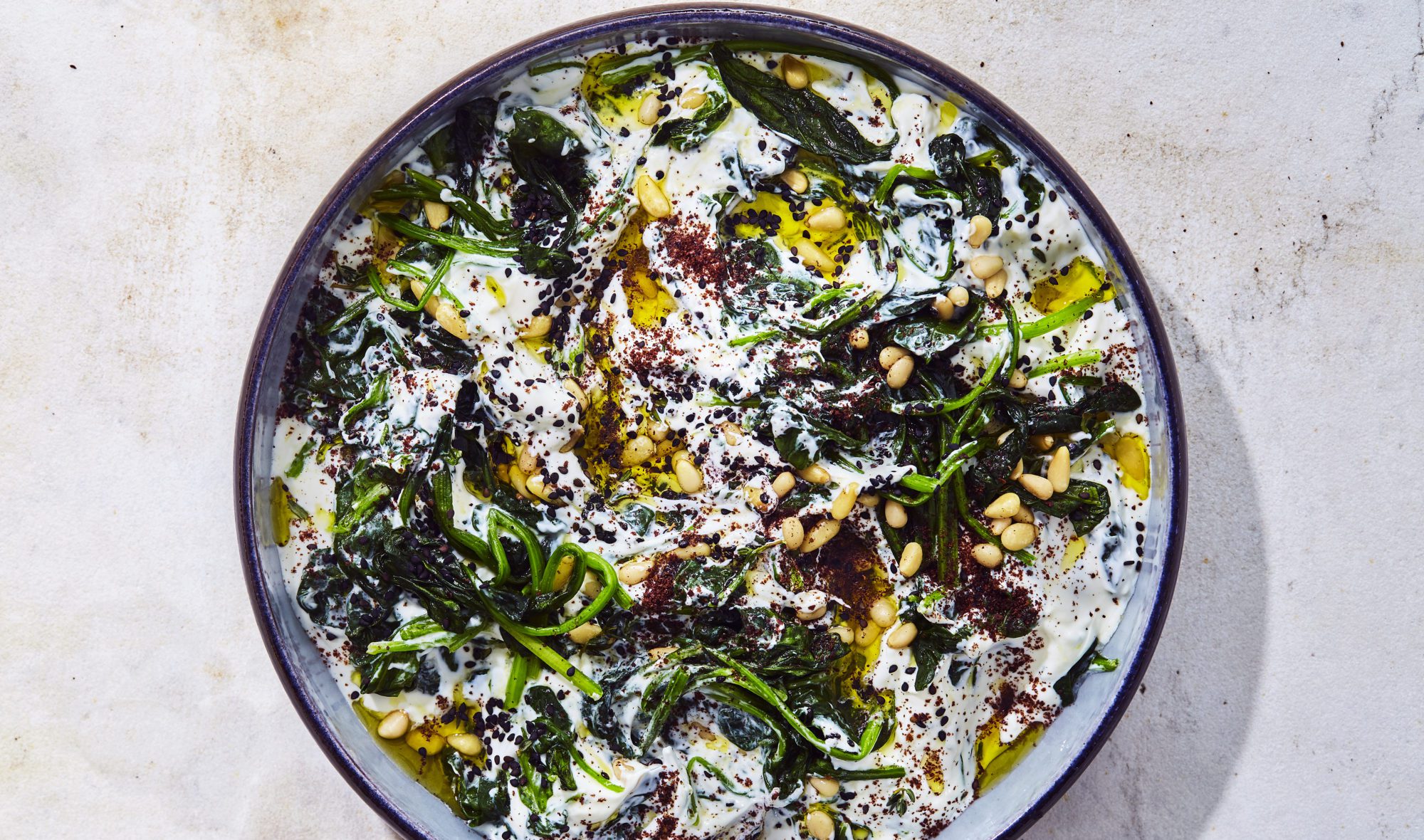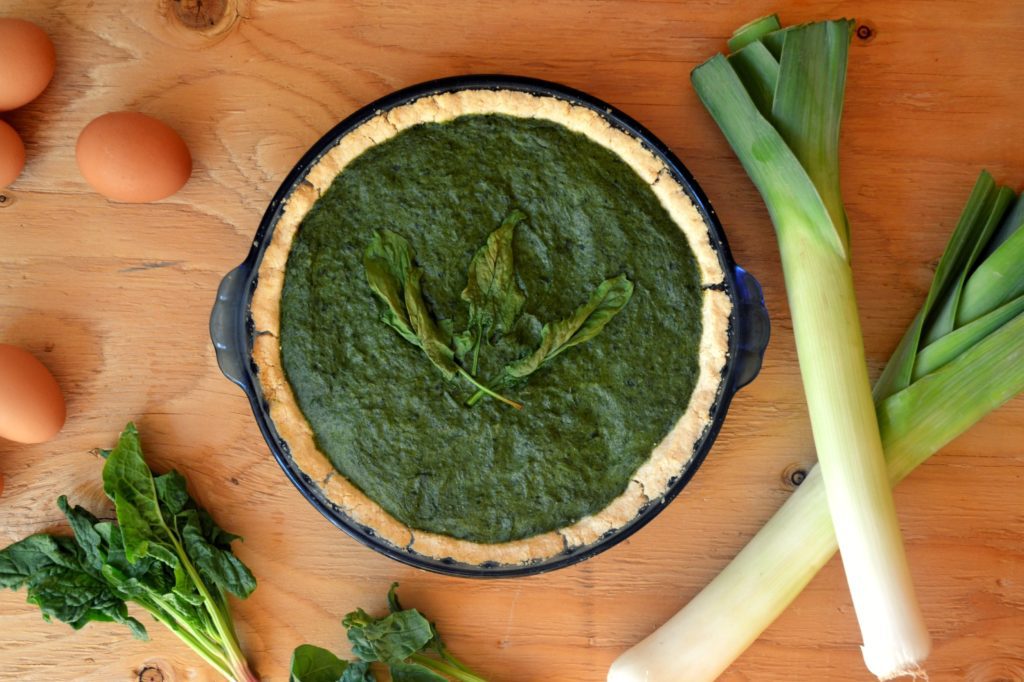
Spinach is the bicep-bulging favorite vegetable of Popeye, and one of the most nutrient-dense, widely available plants. Spinach is a bright green, tender leaf that has a mild, slightly sweet taste with a pleasant mineral undertone. Like many leafy greens, spinach is very high in nutrition relative to its caloric content; It is an excellent source of vitamin K, vitamin A, manganese, and folate, and a good source of magnesium, iron, copper, and riboflavin (vitamin B2). Due to its high oxalic acid content, the nutrients in spinach may be more absorbable in its cooked form. When cooking spinach, overestimate! Cooked spinach reduces dramatically: Over ten cups of raw spinach will yield a mere cup when cooked!
It was a favorite of Popeye’s for a reason: Spinach is one of the most accessible, nutrient-dense vegetables available to us.
A member of the chenopod family, which also includes beets, Swiss chard, and quinoa, spinach is thought to have originated in Persia. Eventually, it migrated to China, then to Spain, and on to England, where it was quickly adopted, as it was resistant to cold temperatures and ready for harvest early in spring, a time when other vegetables were scarce.
Today, the undisputed biggest producer of commercial spinach is China, followed (far behind) by the United States. However, there is debate about which geographical region has earned the title of “Spinach Capital of the World”. Currently, two cities in the US are vying for this honor: Alma, Arkansas and Crystal City, Texas.
Perhaps the most impressive thing about spinach is the magic trick it pulls when you cook it. When cooked, spinach reduces to less than 10% of its original volume when fresh. That means over ten cups of fresh spinach will cook down to one cup. Which means you can pull your own magic trick (to eat ten cups of spinach in one sitting).
Spinach is a beautifully bright, grass-green leaf that has a mild, slightly sweet taste with a subtle minerality. Raw spinach is water-rich and tender, and cooked spinach is soft and rich-tasting.
There are several different types of spinach on the market, all with slight variations in texture and shape:
Immature leaves (also known as “baby spinach”) are also available and are the favored form for salads and quick meals. Small, smooth, and spoon-shaped, baby spinach is typically sold pre-washed and ready-to-eat in plastic clamshells. Baby spinach is tenderer and less bitter than the mature leaves that are often sold in bunches.
Two cups of raw spinach (about 60g) has 14 calories, 1.7g of protein, 0.2g of fat, 2.2g of carbohydrates, 1.3g fiber, and 0.3g sugar. Spinach is an excellent source of vitamin K, vitamin A, manganese, and folate, and a good source of magnesium, iron, copper, and riboflavin (vitamin B2).
Note that the above values are for raw spinach. As previously mentioned, spinach shrinks drastically when cooked, so two cups of raw spinach will be much less nutrient dense than two cups of cooked spinach.
Additionally, although raw spinach is very nutritious, it is also very high in a compound called oxalic acid. Oxalic acid is found in many leafy green vegetables that may inhibit the absorption of minerals during digestion. Cooking vegetables reduces their oxalic acid content.
Spinach is widely available in most grocery stores and fresh produce markets.
The best options are either fresh or frozen spinach.
Fresh spinach is typically sold in bunches or loose in plastic clamshells or bags. In all cases, look for spinach whose leaves appear firm and bright green, with no signs of yellowing, wilting, or sliminess.
Frozen spinach is often sold in packed cubes or rounds, in boxes or bags. In this case, the most important thing is to read the ingredients. These products should contain nothing more than spinach.
The Environmental Working Group has consistently listed spinach as one of their “dirty dozen” produce items. The fruits and vegetables on this list tend to be among the most heavily pesticide-contaminated produce. For those trying to reduce their exposure to chemicals, choose organic spinach products.
Store fresh spinach in the container it came in, being sure to seal it well. It will stay fresh for about five days. Do not pre-wash spinach before storing it as it will wilt and perish more rapidly.
Cooked spinach does not keep well in the fridge and should be eaten within a day or so after cooking. However, cooked or blanched spinach does freeze well, and can be kept in the freezer for up to six months.
Fresh spinach sold in ready-to-eat salad bags or clamshells need minimal preparation and can technically be eaten right out of the container.
However, secured bunches of spinach are dirt-traps and need to be washed thoroughly in order to remove sand, soil, and other gritty bits before its ready for consumption. Here’s how to do it:
Before washing, trim off the bottom portion of the stems, which tend to be coarse and especially dirty. Then, place the leaves in a large bowl of cool water and swish the leaves around with your hands. This will help any grit to become dislodged. Strain the leaves and discard the dirty water, then refill the bowl with clean water. Repeat until the water runs clear (usually two to three times).
After proper washing, spinach can be chopped up and added to a salad, on thrown into a skillet with a pat of butter and some minced garlic, where it will cook in mere minutes over medium-high heat.

Freak out/delight your kids and other dinner table guests with this beautiful savory green pie. Reminiscent of quiche, this pie has a soft, yet sliceable texture and the delicious flavors of leek, spinach, and creamy goat cheese.
Prep Time: 25 minutes Cook Time: 50 minutes Yield: One 9 inch pie
For the Crust:
In a large bowl, add almond flour, potato starch, and salt. Stir to combine.
Using clean hands, mix in butter/oil until you get a uniform, packable, sandy-textured mixture.
Mix in egg and water. Again, this will be easiest using your hands. This should yield a very crumbly, but packable dough.
Transfer your dough crumbles to a greased pie pan and, using your hands, pack the dough into a crust shape. Try to get make the crust fairly uniform in terms of thickness by using your fingers to press the dough into place. For a nice presentation, finish by crimping the top edges of the crust with your fingers.
Place your pie pan in a 350 degree Fahrenheit preheated oven, and bake for 10-12 minutes. Allow to cool slightly. Set aside and make the filling.
For the Filling:
In a large wok or pan, add leeks, butter/oil, and salt and cook over medium-high. Once the leeks are fragrant and soft (about 5-7 minutes), add the spinach, and cook until wilted.
Transfer cooked vegetable mixture to a blender or food processor, add cheese and blend. Allow to cool slightly before adding eggs, and then blend until desired texture is reached.
Pour the filling into the baked pie crust and smooth out the top with a spatula. Garnish with a few spinach leaves, a few sprigs of fresh herbs, or thin slices of fresh tomato, if desired.
Bake in a 350 degree Fahrenheit oven for 35-40 minutes. When done, the top of the pie should feel firm, and if you insert a toothpick into the center of the filling, it should come out clean. Allow to cool slightly before slicing.
Enjoy!
Precision Nutrition’s Encyclopedia of Food expands every single month as we highlight new foods and showcase beautiful food photography. If you’d like to stay up to date, simply click this link. From there, we’ll send you a FREE copy of our recipe book. We’ll also let you know when new and delicious foods are added to the site.
Spinach is the bicep-bulging favorite vegetable of Popeye, and one of the most nutrient-dense, widely available plants. Spinach is a bright green, tender leaf that has a mild, slightly sweet taste with a pleasant mineral undertone. Like many leafy greens, spinach is very high in nutrition relative to its caloric content; It is an excellent source of vitamin K, vitamin A, manganese, and folate, and a good source of magnesium, iron, copper, and riboflavin (vitamin B2). Due to its high oxalic acid content, the nutrients in spinach may be more absorbable in its cooked form. When cooking spinach, overestimate! Cooked spinach reduces dramatically: Over ten cups of raw spinach will yield a mere cup when cooked!